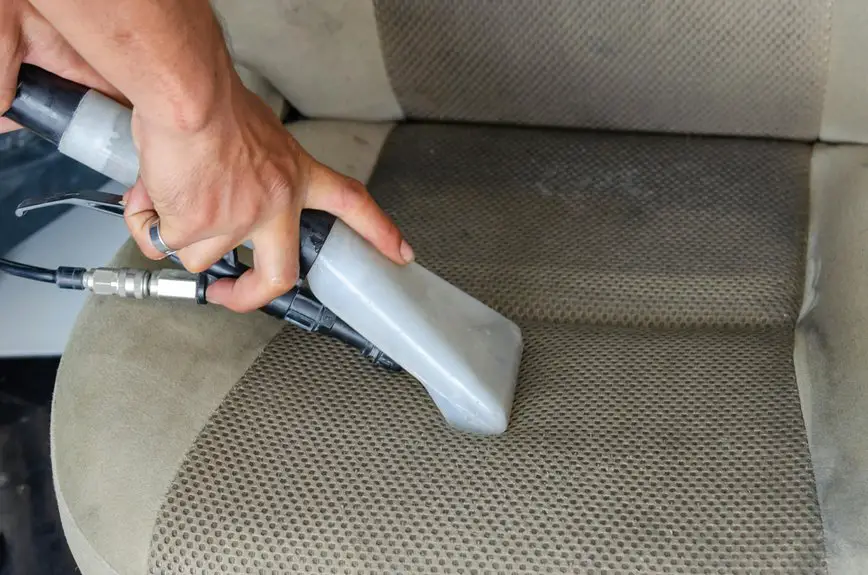To remove sunscreen stains from your upholstery, first check the fabric type to avoid damage. Gently scrape off excess sunscreen and blot the area with a clean cloth. Mix mild dish soap with warm water and dab the stain, then rinse with a damp cloth. For stubborn stains, try diluted white vinegar. Always test on a hidden spot first, and let the fabric air dry. Keep in mind, there are more tips to help keep your furniture spotless and safe.
Table of Contents
Key Takeaways
- Gently scrape off excess sunscreen and blot the stain with a dry cloth to absorb oils before cleaning.
- Test a hidden area for fabric safety before applying any cleaning solution.
- Use a mild dish soap mixed with warm water to gently dab and dissolve sunscreen oils.
- Rinse the area with a damp cloth using plain water to remove soap residue and avoid setting the stain.
- Allow upholstery to air dry completely, avoiding heat to prevent mildew and further staining.
Identifying the Type of Upholstery Fabric
Before you tackle sunscreen stains, you’ll need to identify the type of upholstery fabric you’re dealing with. Different fabrics react uniquely to cleaning agents, so knowing your upholstery material helps you choose the safest and most effective stain removal method.
Check the manufacturer’s tag if you can; it often lists fabric content and cleaning codes like W, S, WS, or X. If there’s no tag, look closely at the texture and weave.
Natural fibers like cotton and linen feel breathable and soft, while synthetics such as polyester or nylon are smoother and more durable. Velvet and microfiber have distinct textures you can recognize by touch.
Identifying the fabric correctly prevents damage and guarantees you don’t set the stain deeper during cleaning.
Preparing the Stained Area for Cleaning
Knowing your upholstery fabric sets you up for success when dealing with sunscreen stains.
Before you tackle the stain, gently remove any excess sunscreen with a dull knife or spoon—avoid rubbing, as that pushes the stain deeper.
Next, blot the area with a clean, dry cloth to soak up oils without spreading the stain. If your fabric can handle moisture, lightly dampen the cloth with cold water and blot again to loosen residue.
Always test a hidden spot first to verify no damage or discoloration occurs. Avoid saturating the fabric, which can harm certain upholstery types.
Finally, keep the stained area dry and avoid heat, as this can set the stain further, making it tougher to remove later.
Using Household Ingredients to Treat Sunscreen Stains
While sunscreen stains can be stubborn, you can often tackle them effectively using common household ingredients.
Start with a mixture of mild dish soap and warm water; it breaks down oils in the sunscreen without damaging your upholstery.
Begin by mixing mild dish soap with warm water to gently dissolve sunscreen oils without harming fabric.
For tougher stains, combine equal parts white vinegar and water to neutralize grease and lift discoloration.
Baking soda is another great option—sprinkle it on the stain, let it sit for 15 minutes, then vacuum it off to absorb oils.
Lemon juice can also help, but use it sparingly to avoid fabric damage.
Always test these solutions on a hidden spot first to verify they won’t cause fading or harm.
These simple ingredients can often restore your upholstery’s appearance without harsh chemicals.
Step-by-Step Cleaning Process for Upholstery
To clean sunscreen stains from upholstery effectively, follow a clear step-by-step process that targets the stain without harming your fabric.
First, gently blot the stain with a clean cloth to absorb excess sunscreen—avoid rubbing, which spreads it.
Next, mix a solution of mild dish soap and warm water. Dip a soft cloth into the solution and dab the stained area, working from the outside in.
After a few minutes, use a separate cloth dampened with plain water to rinse the soap. Blot the area dry with a clean towel.
If the stain persists, apply a small amount of white vinegar diluted with water, then rinse and dry again.
Finally, let the upholstery air dry completely before use to prevent mildew.
Preventative Tips to Avoid Future Sunscreen Stains
Although sunscreen is essential for protecting your skin, it can easily leave stains on your clothes and upholstery if you’re not careful.
To prevent future stains, apply sunscreen at least 15 minutes before sitting on furniture or wearing clothes that might absorb it. Use a towel or cover upholstery with a washable throw when relaxing outdoors.
Apply sunscreen 15 minutes before contact and use covers to protect furniture from stains.
Choose sunscreens labeled as “non-greasy” or “streak-free” since they’re less likely to leave marks. Wash your hands thoroughly after applying sunscreen to avoid transferring it onto surfaces.
If you’re using spray sunscreens, apply them in well-ventilated areas and avoid overspraying near fabric. Regularly clean upholstery to catch any residue early.
These simple steps help keep your furniture stain-free and your home looking fresh.
Frequently Asked Questions
Can Sunscreen Stains Damage Upholstery Permanently?
About 30% of upholstery stains become permanent if untreated. If you don’t act quickly, sunscreen stains can damage your fabric permanently, so you’ll want to clean them promptly to avoid lasting discoloration or fabric weakening.
Is Professional Cleaning Necessary for Sunscreen Stains?
You don’t always need professional cleaning for sunscreen stains. If you act quickly and use the right cleaning methods, you can often remove them yourself. But for tough or old stains, professionals might be your best bet.
Are All Sunscreens Equally Likely to Stain Fabric?
You might think all sunscreens stain equally, but they don’t. Some formulas, especially those with oils or certain chemicals, are more prone to leaving marks on fabric. So, check ingredients to see which might cause stains.
How Quickly Should Sunscreen Stains Be Treated?
You should treat sunscreen stains as soon as possible because they can set quickly. The sooner you act, the easier it’ll be to remove the stain completely and prevent permanent damage to your upholstery.
Can Sunscreen Stains Be Removed From Leather Upholstery?
Think of sunscreen stains on leather like a stubborn smudge on your favorite painting—it’s tricky but not impossible. You can remove them gently using a leather cleaner and conditioner, avoiding harsh scrubbing to protect the material.
- The Use of Nonwovens in Construction and Civil Engineering - July 11, 2025
- The Use of Nonwovens in Construction and Civil Engineering - July 11, 2025
- The Use of Nonwovens in Construction and Civil Engineering - July 11, 2025







